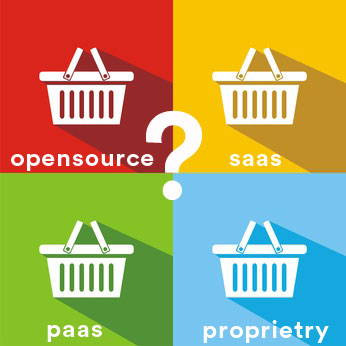 There are 4 main types of ecommerce platform.
There are 4 main types of ecommerce platform.
1. opensource E.G. opencart, prestashop, magento,woocommerce, virtuemart, zencart, oscommerce, cs cart etc. No license fees. Just hosting and 1 off design / development costs at start up.
2. licensed and hosted by the store owner ( paid magento, actinic, shopify ), continous fees.
3. Saas ( volusion, shopify, bigcommerce ) continous fees increasing with your volumes. Your Business Information can get locked in these systems.
4. Pass ( platform as a service , e.g b2b selling platforms with extensive API ) continous fees.
It depends how much control you want over your store and how you see your store growing as to what product you choose. You have to think into the future. A short cut now can maybe expensive later. Think of the international dimension, high volume, mobile commerce, and hosting requirements.
If you want to control absolutely everything then go opensource. You get the source, you provide the hosting and you can change it to do anything you wish. Moving to another platform will require a migration of data. These can be linked to in-house account systems. Opensource systems tend to develop with trends quicker. Bug fixes are available fast and available for free. You may have to engage with a developer to do your updates.
If you want the support of an organisation and their management of your site then a licensed product is the way to go. Moving to another platform will require a rebuild. Some vendors on gaining a critical mass of customers stop developing their products and rest on the license fees. If the product stagnates then the competition passes you by and you are trapped until you decide to rebuild. Closed source systems are usually 3rd or 4th generation platforms for successful ecommerce businesses.
Saas products are pay as you go, they are the same as the license product except they are paid for monthly and include the hosting. Exporting data out for migration to another platform is usually very limited or not an option. Moving platform requires a rebuild. The advantage is that its quick setup but the downside are the hidden monthly fees that are usually linked to transaction volumes. So the more you turn the higher your saas fees. There are many saas platforms and many different billing methods.
Paas is Platform as a service : this is for advanced mature B2B where you are looking to link your ecommerce into other systems that your customers use for procurement, like SAP, Ariba, Punchout2Go. It allows B2B clients to link their purchasing systems directly into your B2B ecommerce platform. This is vital if you are selling into large companies who have complex procurement systems that they process their purchase orders through. With a Pass ecommerce you are looking for flexible apis that can interface with other systems. You will need a developer to implement this.
Our advice for control, flexibility and future proofing is an opensource solution. Think of the next step can I scale to 20,000 sales per month with this system, without blowing up and or costing me a fortune in sales commissions.
Think of where your business intelligence is and have you full access to it and do others have access to it. Many quick to implement solutions have a sting in their tail. It is usually fees based on turnover, and the locking up of your business intelligence, not to mention seeing your sales and successes.

